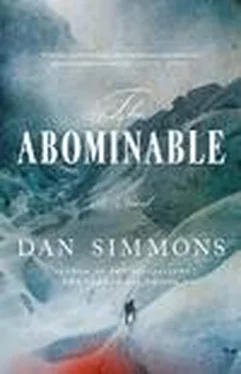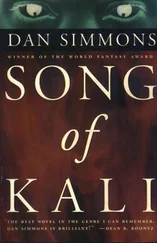“Did you happen to know Major Owings during the War?” asked Reggie.
“Yes, I knew him then,” said the Deacon. “And before.” He stood up and slapped his knees. “It’s getting late. Are we going to get Semchumbi busy cooking something tonight or just turn in hungry?”
Leaving the Rongbuk Monastery with many of the Sherpas grumbling about the lack of a blessing—grumbling at least until Dr. Pasang shouts them into a surly silence—the thirty-five of us trudge two miles down the valley and across the river toward the mouth of the Rongbuk Glacier until we reach the site of the three earlier expeditions’ Base Camp about an hour or so before sunset. The futile waiting at the monastery for the head lama Dzatrul Rinpoche to see us has wasted too much of our day.
I confess that I’m feeling somewhat depressed by the time we reach the Base Camp site. All three expeditions have camped at exactly this spot—within the glacier valley but shielded from the worst winds by a 40-foot-high moraine-rock ridge to the south, view open to the north whence we’ve just come, flat spots for the tents (some even free of larger rocks), and a small melt lake where the ponies, mules, and yaks we’ve traded for can drink. A glacial stream runs nearby, and although the water has to be boiled before drinking because of the nearby animal and human waste, and we prefer to melt clean snow to drink, the stream gives us water for bathing.
But there’s also filth and debris from the three previous British expeditions: tatters of torn tent canvas and broken poles; a litter of discarded oxygen tanks and frames; low rock walls that the wind has managed to tumble in places, heaps of not-yet-rusting discarded tin cans by the hundreds, some still full of rotting uneaten delicacies from last year’s expedition; and to the left of the main camping area, an obvious spot for the latrines along a line of flat stones. We’re greeted by hundreds of freeze-dried human turds lining a trench neither dug deep enough nor filled in when Norton and the others retreated from this spot.
Even more depressing, just downhill from the trashy site of Mallory’s base camp rises the tall pyramid of stones that the previous expedition raised as a memorial to those who’ve died on the mountain. The top inset boulder had been painted to read IN MEMORY OF THREE EVEREST EXPEDITIONS and below that is a boulder inscribed 1921 KELLAS in memory of the physician who died during the 1921 reconnaissance expedition that the Deacon had been part of. Below that, Mallory’s and Irvine’s names are inset there, as are the names of the seven Sherpas who died in the 1922 avalanche. The rock-pyramid memorial seems to turn the entire Base Camp area into a cemetery.
But grimmest of all somehow is the un-Matterhorn-like massif of Mount Everest itself, still some twelve miles up the windblown Rongbuk Glacier valley. We can see its western flanks and ridges glowing in the evening light during a break in the snow and near-constant cloud cover, but even at this distance, the mountain seems misshapen and far too large. Rather than a distinct mountain like Mont Blanc or the Matterhorn, Everest seems more like one infinitely huge fang along an impossible barrier of gigantic teeth. The wind spume from its summit and ridges now extends beyond the horizon to the east, streaming high above nearby Mount Kellas and the taller—and also too large, too tall, too steep, too massive, too distant—Himalayan peaks which stretch like a wall built by gods to block our path.
I can sense the Deacon’s distaste at setting up a camp here, but the Sherpas will carry no further this long day. The Deacon had always wanted to set up our first Base Camp more than three miles farther up the valley, where Camp I or Advanced Base Camp had been in the earlier efforts. But this Base Camp is already at 16,500 feet—more than 12,500 feet below Everest’s impossible summit but still high enough to leave most of us gasping with our 60-pound loads. Camp I, according to what both the Deacon and Reggie have said, is at 17,800 feet, and—while it is said to catch the most sun of any of the Everest camps—it is often much more exposed to the winds whipping down off the North Face of Everest and scouring the glacier. There’s more ice than moraine rock up there, and Dr. Pasang has pointed out that it will be harder to recover from altitude sickness with even just another 1,300 feet of altitude beneath us. Reggie’s made a good argument during the five weeks of camp evenings that we should establish the first line of tents here—someplace to retreat to when altitude sickness strikes—and the Deacon no longer seems interested in arguing the point. He plans to cache almost all of the high-climbing equipment at Camp II, six miles above Base Camp.
Now he dumps the heavy load he’s been carrying, pulls an almost empty rucksack from it, and says to Reggie, “Go ahead and supervise the establishment of Base Camp here, if you will, Lady Bromley-Montfort. I’m going to reconnoiter up the valley as far as Camp One.”
“That’s ridiculous,” says Reggie. “It will be dark before you get there.”
The Deacon reaches into the almost empty rucksack and pulls out one of Reggie’s leather battery-lamp headpieces. He flicks its headlamp on and then off. “We’ll see if this Welsh miner contraption works. If not, I have an old-fashioned hand torch in my rucksack.”
“You should not go alone, Ree-shard, ” says Jean-Claude. “And especially not onto the glacier. The crevasses will be impossible to see in the twilight.”
“I won’t have to climb onto the glacier proper just to reach Camp One,” says the Deacon. “I have some biscuits in my jacket pocket, but would greatly appreciate it if you would keep some coffee and soup warm for me.”
He turns and disappears up the valley of gathering shadows.
Reggie calls Pasang over, and within minutes they are organizing the tired Sherpa porters, unloading the yaks and mules, and deciding which tents to erect where in this strangely sad place. Pasang directs the lifting of a large Whymper tent rainfly inside one of the crumbling sangas, or rock walls, hangs curtains on the side, and declares this the medical tent. Several Sherpas line up for consultation and treatment almost at once.
Our valley is in darkness, but Everest blazes far beyond and above us in a cold, powerful, self-contained isolation. That strikes me as terrifying.
It was our last night in Sikkim—April 2—right before we crossed over the Jelep La into Tibet, when I celebrated my 23rd birthday. I hadn’t told anyone about the date, but someone must have noticed it on my passport, because we definitely had a celebration.
I don’t even remember the name of the tiny village some 12 or 13 miles between Guatong, where we stayed that night, and the border—perhaps it had no name, it certainly had no dak bungalow—but it did have what I called a Ferris wheel and what the Deacon called “a miniature version of the Great Wheel at Blackpool” and what Reggie called “a little version of the Vienna Wheel.” The thing was crude, built out of raw lumber, and consisted of four “passenger cars” that were little more than wooden boxes one crawled into. At its high point, this “Great Wheel” couldn’t carry a person’s feet more than ten feet above the ground, and the mechanism to make it work, once I’d been coaxed into sitting in one of the boxes, consisted of Jean-Claude pulling the next car down on one side and the Deacon pushing up on the other. The contraption must have been built for the village children, but we’d seen no children on our way into the village and would see none before we left in the morning.
Then they stopped me at the nominal high point—all eight of the village huts were spread out in panorama, their rooftops just a little higher than my knees—and Reggie, the Deacon, Jean-Claude, Pasang, and several of the English-speaking porters began singing “For He’s a Jolly Good Fellow” followed by a ragged chorus of “Happy Birthday.” I confess to blushing wildly as I sat there with my wool-stockinged legs dangling.
Читать дальше












